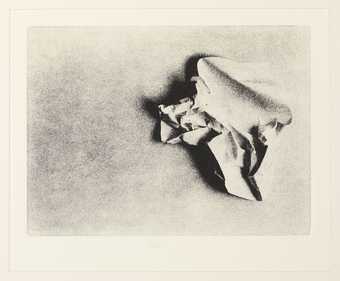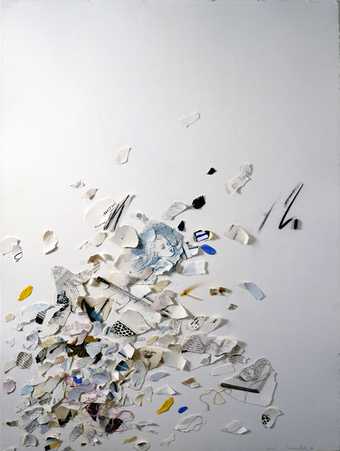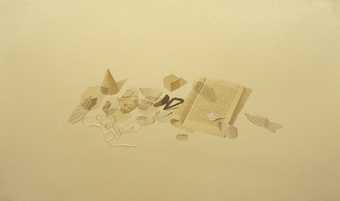In an analysis of Liliana Porter’s work, critic and curator Inés Katzenstein remarks on its ability to never quite fit into any fixed category:
[W]e could situate her in different ‘isms’, trace her influences, and deconstruct her context, yet her work established a differential with respect to the most common forms of art, which places her at an unusual margin: it is a marginality that, rather than inching toward the obscure and hermetic, retreats from the central or the canonic through its tendency to move toward the horizon of communication.1

Fig.1
Liliana Porter
Wrinkle 1968
One of ten photo-etchings on paper
Image, each: 216 x 186 mm
Tate P13236
© Liliana Porter
The text written by the Fluxus poet Emmett Williams and included as a prologue to Wrinkle 1968 (Tate P13236) also reflects on Porter’s ambition to resist the encyclopaedic urge to have her work pinned down to a specific category or genre. As Williams points out in the mock interview in Wrinkle, Porter’s work offers a subtle, yet stubborn, resistance to attempts to place an identification tag on it. In the text, the poet ponders the nature of Porter’s work: as ‘not pictures’, ‘still-lifes of action paintings’ or ‘a still-life of a dynamic process’, even going so far as to describe them as sorts of ‘landscapes’ and turning the artist herself into a kind of ‘cartographer’. By using this latter term, Williams refers to the topological aspect of the work in which the progressive creasing of the paper could also be read as the geological formation of a relief (fig.1). At the same time, however, the metaphor is particularly appropriate in that Porter’s art practice could be conceived as the cartography of an unknown territory, blending reality and imagination together. This essay examines Porter’s interest in blurring pre-existing artistic categories and analyses the literary referents present in her work.
‘The ambiguous limit’
In an interview published by the gallery Machete, Porter has remarked on the main idea driving her work. She explains:
I think that all artists have a base theme or, to put it another way, a central concern that is present in all of their works. In my case, this topic concerns my awareness of the ambiguous limit that exists between what we call reality and what we call representation. I am interested in the space between the word and the thing, between the thing and myself.2
In this definition Porter outlines two elements crucial to understanding her practice: her examination of the porous line separating reality from its representation, and the profoundly relational nature of her pieces. While slightly different, these two points ought to be taken together in any account of Porter’s works: they can be regarded as a series of poetic reflections on the imaginary sphere, the border between the real and the fictional.
Porter’s installation works, such as the series Forced Labor 2004– examined elsewhere in this In Focus, provide an illustration of the artist’s exploration of this blurry frontier delimiting the real from its artistic representation.3 They create short narratives that seek to make the two universes meet and enter into dialogue with each other in both their plots and their use of space. Indeed, by placing child-like figurines in incongruous and seemingly absurd situations, Porter opens the door for the fictional and the oneiric to enter the exhibition space, distilling poetic possibilities inside the rationality of the institution. As critic and curator Gregory Volk writes, Porter’s works are ‘mute, but communicative. They seem to not really tell but emanate stories, or rather, scraps and excerpts of silent stories, hints of memories, snippets of dreams’.4 It is worth noting that according to the art historian Florencia Bazzano-Nelson, Porter’s interest in investigating the porous nature of the line separating the real and the imaginary started before the artist’s installation works and goes back to the printmaking experiments carried out by the artist during her years at the New York Graphic Workshop. As Bazzano-Nelson writes,
The experimental environment of the NYGW [New York Graphic Workshop] had encouraged [Porter] to re-evaluate her art and begin a radical change of its formal and conceptual parameters, which eventually resulted in her development of artworks that challenge the limits that separate reality from illusion.5
It seems particularly relevant that, according to Bazzano-Nelson, this ‘transformational process’ materialised in Porter’s first experimental works with wrinkled paper, especially the mail art piece To Be Wrinkled and Thrown Away 1969, as well as the Wrinkled Environments she installed at the Museo de Bellas Artes in Santiago and the Museo de Bellas Artes in Caracas.6 If, conceptually, Porter’s Wrinkle series of prints should be read in connection to her other works on the motif, it should also be examined through the artist’s increasing interest in traversing this blurry frontier.
Reality and representation
The most ‘real’ part of Wrinkle might initially appear to be the piece of paper which, under the artist’s manual intervention, underwent a series of scrunching and creasing actions which she subsequently registered in two layers of representation: the photograph and the print. The technical aspect of the work’s production is therefore central to Porter’s reflection on the transformation of a ‘thing’ into a work. Photography in particular comes to play a crucial part in this process. As the artist remarks, ‘I perceived the photograph as the most objective kind of image possible, an instrument that allowed me to appropriate objects from reality (for example a nail) and then print them on a wall; or I could put situations together, take a photograph of them, and insert the photograph into a print’.7 The intervention of the photographic apparatus thus partakes in the construction of a realm of fictional representation that, while taking reality as its raw matter, also comes to compete with and expand it. In Wrinkle, the three stages experienced by the piece of paper are acted upon precisely through technical interventions: from the ‘real’ piece of crumpled paper to its photographic replica and, on a third level, the print that is produced from the photograph. While this technical aspect might be taken as the work’s raison d’être, it also opens up a dialogue between three different stages of the paper’s existence.
Philosopher Roland Barthes identified a nostalgic, if not ghostly, element in the medium of photography. Beyond the lure of modern technology, Barthes writes, photography is ultimately a medium that allows for the past to resurface in the present, making it not only visible but also palpable. The photograph functions as ‘a sort of umbilical cord’ bringing death back into life, uniting the represented thing or person to its representing image.8 In a similar way, Porter’s photo-etchings grant a sense of permanence to the damaged piece of paper, inscribing it in the realm of the present. Moreover, this idea of photography as a time-travelling machine operating between different times and universes also contributes to the separation of the real from the imaginary, turning the chemical surface of the plate into a space for fiction to emerge. It is therefore not surprising to note that in her ambition to produce porous works using different techniques and media, Porter also made frequent reference to literature, which she arguably used as an auxiliary field to reflect on her own life, as well as the nature of art and representation.
Down the rabbit hole: Porter’s literary influences
During her youth in Mexico, Porter befriended young writers such as Emilio Pacheco and Carlos Monsivaís, as well as becoming acquainted with established ones including Octavio Paz and Alonso Reyes. All of them would play a crucial part in stimulating the artist’s literary interests.9 Literature appears in Porter’s works in two ways: as a source of influence as well as, in some instances, an explicit motif. Two sets of literary works in particular recur in her prints: Lewis Carroll’s Alice’s Adventures in Wonderland (1865) and the short stories written by Argentine author Jorge Luis Borges.

Fig.2
Liliana Porter
Alice 1988
Collection of the artist
© Liliana Porter
Carroll’s famous book tells the story of a young girl named Alice who, on a dull afternoon in the English countryside, chases a tuxedo-clad white rabbit that is talking to itself and falls into a deep rabbit hole. The universe she encounters thereafter is a topsy-turvy world in which anthropomorphic animals speak and grin, babies turn into pigs, and Alice herself keeps on growing and shrinking to extents that always make her feel utterly out of place. At the end of the novel, Alice is banned from the kingdom due to her inability to conform to its height standards. While often read as a fantasy novel, Carroll’s book is also an important reflection on the search for identity and the desire to fit with one’s surroundings. Porter’s interest in the story of Alice has often been interpreted in light of the feelings the artist herself experienced when moving and having to acclimatise to New York, settling into life in a different country and using a different tongue.10 This parallel comes through particularly potently in a 1988 collage by Porter that is simply titled Alice (fig.2). In the work, the artist has glued to a blank page torn bits of Carroll’s books, such that they look as if they are being blown away by a strong gust of wind. In the middle of this storm the face of Alice appears, taken from one of the illustrations from the book. Looking rather dishevelled, she floats in this matrix of words and images towards an unknown destination. If Wrinkle and others of Porter’s works emit a subtle silence, this one is undoubtedly loud, revealing an unexpected aspect of the artist’s practice and potentially appealing to a time of turmoil in her own life.
Art historian Janis Bergman-Carton, who has written about the symbolism of literary motifs in Porter’s works, identifies a clear parallel between the experiences of Alice and Liliana: ‘so disoriented by her shifting size in the world she has encountered down the rabbit hole, Alice forgets how to speak her native tongue and wonders if she is “the same as when she got up that morning… Who in the world am I?”, she queries’.11 This sense of self-alienation may have touched a nerve in Porter as she tried to get comfortable with her own life as a foreigner, argues Bergman-Carton. The Alice motif would thus constitute ‘the artist’s responses as an Argentine to the multiplicity of linguistic and cultural identities she has encountered in her tumble down the rabbit hole into New York’.12 Porter partly corroborated this interpretation when, in an interview, she discussed her Argentine heritage as a crucial part of her identity: ‘even though I have been living in New York since 1964 (when I was twenty-two years old), I still feel that I am fundamentally Argentine. It is clear that this impacted my understanding of things’.13 Moreover, while she recognises that the multiculturalism that defines New York certainly did not make her unique in this respect, Porter also draws a parallel between the cultural alienation she might have felt at the start of her life in the US and her own playful approach to language: ‘When you have to substitute the name of everything in order to be able to communicate (in my case, traducing from Spanish into English), you understand at a deeper level that in essence, things don’t have names, that names only have the meaning that we momentarily attribute them’.14 In Wrinkle, if the piece of paper may be loosely associated with the world of letter-writing, a more specific correlation may be drawn between it and the Carrollian motif of alienation, specifically through the white, unmarked state of the depicted piece of paper. Wrinkle’s white sheet would then come to symbolise the blank slate that moving to New York represented in Porter’s own story: a chapter in the making whose provisional nature would have appeared both exhilarating and terrifying.

Fig.3
Liliana Porter
Fragments with Borges’ Book 1983
Hamaguchi Study Print Collection, California College of the Arts Libraries, Oakland
© Liliana Porter
Literary motifs also fulfil another function in Porter’s oeuvre in a way that could help shed light on the symbolic nature of the paper in Wrinkle. If Carroll’s Alice represented a valuable interlocutor in Porter’s own experience of exile, it was to Jorge Luis Borges that the artist turned when attempting to make sense of her own artist practice. For her 1983 work Fragments with Borges’ Book (fig.3), for instance, Porter used collage and silkscreen prints to create a still life depicting various objects, including a copy of a book by the Argentine author from which she seems to have torn pieces that float around the composition like sails or leaves. In this work Porter appears to reflect on the odd transubstantiative process that art and literature perform in their ability to transform mundane materials such as ink and paper into highly codified supports for the production of meaning. By tearing off pages from Borges’s book and using them in her work, however, Porter also refers to the reverse process of bringing words and images back to their materiality. This questioning of the nature of artistic and literary creation was also a recurrent concern for Borges. His short story ‘The Book of Sand’ (1975) tells of an infinite book without any specific page numbering, whose contents constantly changed, making it impossible for the reader to find the same page twice. Just like sand, ideas would seep through the hands of the reader. Meanwhile, Borges also explored the opposite hypothesis in an earlier short story, ‘The Library of Babel’ (1941), which described an infra-world in which a team of over-zealous librarians would strive to find the perfect book able to summarise all of the world’s knowledge and language in one single volume.
According to the art critic Gerardo Mosquera, the kinship between Borges and Porter is more semantic than literal, as it reveals similar views of the world and of language. Moreover, by both poking fun at and resisting the humanist urge to categorise knowledge, both share what Mosquera calls an ‘anti-taxonomic’ tendency – a reluctance to adhere to pre-established categories and genres.15 Looking at Wrinkle through this Borgesian prism, the work reveals itself as a metaphor of creation in the making, the minimal condition required for meaning to constantly form and un-form itself. At the same time, this effort to strip works down to their bare conceptual condition is visually deployed in Porter’s use of blank spaces, which serve to isolate objects from their contextualising surroundings. As the artist explains:
I know that white space is essential in my work. It takes the object out of any and all contexts and temporalities. I don’t know if this is entirely possible, but I’m trying to eliminate the distraction between ‘oneself’ and the thing … There, the subjective is simultaneously objective.16
The presence of the blank sheet of paper in Wrinkle therefore relates to Porter’s interest in literature as well as to her own reflection on her life and creative process in a way that could almost look like a self-portrait. As Volk astutely notes, ‘Porter’s work is never overtly autobiographical, yet it seems animated by a profound, deeply felt psychological and social inquiry: the deep self in relation to a fractious and conflicted society’.17
